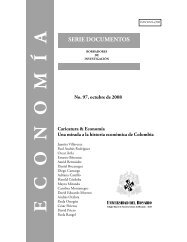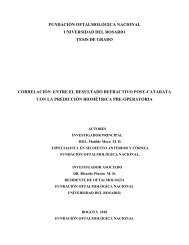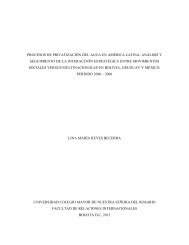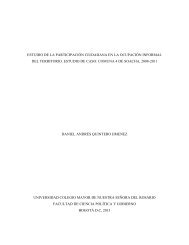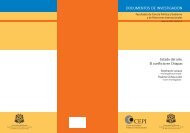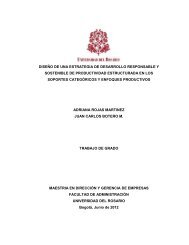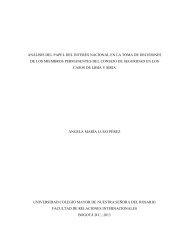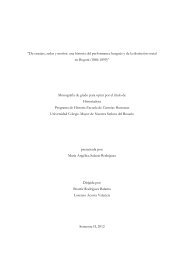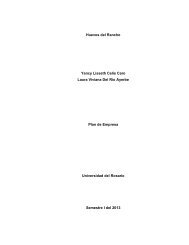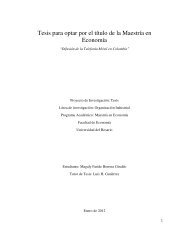Sistemas bio-inspirados: Un marco teórico para la ingeniería de ...
Sistemas bio-inspirados: Un marco teórico para la ingeniería de ...
Sistemas bio-inspirados: Un marco teórico para la ingeniería de ...
You also want an ePaper? Increase the reach of your titles
YUMPU automatically turns print PDFs into web optimized ePapers that Google loves.
<strong>Sistemas</strong> <strong>bio</strong>-<strong>inspirados</strong>: <strong>Un</strong> <strong>marco</strong> <strong>teórico</strong> <strong>para</strong> <strong>la</strong> <strong>ingeniería</strong> <strong>de</strong> sistemas complejos<br />
Pagels, H. (1991). Los Sueños <strong>de</strong> <strong>la</strong> Razón: El Or<strong>de</strong>nador y los Nuevos<br />
Horizontes <strong>de</strong> <strong>la</strong>s Ciencias <strong>de</strong> <strong>la</strong> Complejidad. Barcelona: Gedisa.<br />
Pǎun, G. (2006). Introduction to Membrane Computing. En G. Ciobanu, G.<br />
Pǎun y M. Pérez-Jiménez (Eds.), Applications of Membrane Computing,<br />
Natural Computing Series (pp. 1-42). Berlín: Springer-Ver<strong>la</strong>g.<br />
Pǎun, G. (2005). Membrane Computing: Power, Efficiency, Applications.<br />
En B. Cooper, B. Löwe y L. Torenvliet (Eds.), New Computational<br />
Paradigms: First Conference on Computability in Europe, CiE 2005<br />
Amsterdam, The Nether<strong>la</strong>nds, June 8-12, 2005 Proceedings (pp. 396-<br />
407). Berlín: Springer Ver<strong>la</strong>g.<br />
Price, D.J. <strong>de</strong> S. (1963). Little Science, Big Science. Nueva York: Columbia<br />
<strong>Un</strong>iversity Press.<br />
Prusinkiewicz, P. y Lin<strong>de</strong>nmayer, A. (1990). The Algorithmic Beauty of<br />
P<strong>la</strong>nts. Nueva York: Springer Ver<strong>la</strong>g.<br />
Ronald, E. y Sipper, M. (2000). Engineering, Emergent Engineering, and Artificial<br />
Life: <strong>Un</strong>surprise, <strong>Un</strong>surprising Surprise, and Surprising Surprise.<br />
In M. Bedau, M. John, N. Packard y S. Rasmussen (Eds.), Artificial Life<br />
VII: Proceedings of the Seventh International Conference on Artificial<br />
Life (pp. 523-528). Cambridge, MA: MIT.<br />
Sipper, M. (1997). Evolution of Parallel Cellu<strong>la</strong>r Machines: The Cellu<strong>la</strong>r<br />
Programming Approach. Berlín: Springer-Ver<strong>la</strong>g.<br />
Sipper, M. (1990). The Emergence of Cellu<strong>la</strong>r Computing. IEEE Computer,<br />
18-26.<br />
Solé, R. y Goodwin, B. (2000). Signs of Life: How Complexity Perva<strong>de</strong>s<br />
Biology. Nueva York: Basic Books.<br />
Stewart, I. (1999). El segundo secreto <strong>de</strong> <strong>la</strong> vida: Las nuevas matemáticas<br />
<strong>de</strong>l mundo viviente. Barcelona: Crítica.<br />
Syropoulos, A. (2008). Hypercomputation: Computing Beyond the Church-<br />
Turing Barrier. Berlín: Springer-Ver<strong>la</strong>g.<br />
Talbi, E.-G. (2009). Metaheuristics: From Design to Implementation. Nueva<br />
Jersey: John Wiley & Sons.<br />
Taylor, C. (1991). Fleshing Out Artificial Life II. En C. Langton, C. Taylor,<br />
D. Farmer y S. Rasmussen (Eds.), Artificial Life II, SFI Studies in the<br />
Science of Complexity, Vol X (pp. 25-38). Redwood City: Addison-<br />
Wesley.<br />
23



